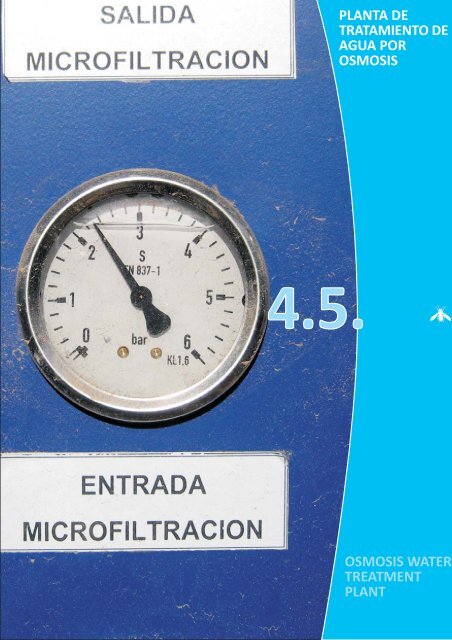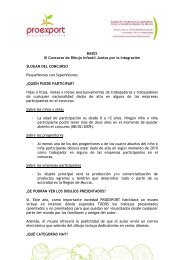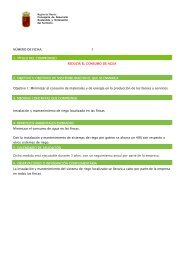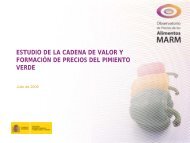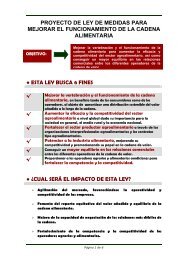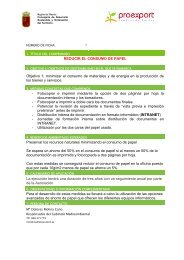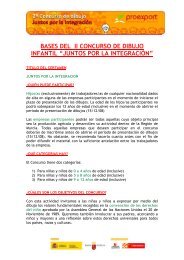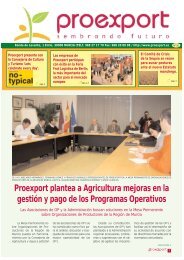09. Planta de tratamiento de agua por osmosis - Proexport
09. Planta de tratamiento de agua por osmosis - Proexport
09. Planta de tratamiento de agua por osmosis - Proexport
Create successful ePaper yourself
Turn your PDF publications into a flip-book with our unique Google optimized e-Paper software.
PLANTA DE<br />
TRATAMIENTO DE<br />
AGUA POR<br />
OSMOSIS<br />
4.5.<br />
OSMOSIS WATER<br />
TREATMENT<br />
PLANT
Las empresas comprometidas con el medio ambiente, han <strong>de</strong> reforzar<br />
paulatinamente la compatibilización <strong>de</strong> la actividad industrial con el entorno<br />
(más allá <strong>de</strong> lo legalmente exigible) mediante la reducción continua <strong>de</strong>l impacto<br />
medioambiental, a través <strong>de</strong> la innovación tecnológica y la realización <strong>de</strong><br />
inversiones medioambientales. Por todo ello, empresas <strong>de</strong> PROEXPORT han<br />
<strong>de</strong>cidido implantar una tecnología para el <strong>tratamiento</strong> <strong>de</strong> <strong>agua</strong> que permita<br />
obtener <strong>agua</strong> <strong>de</strong>smineralizada con el mínimo impacto medioambiental posible,<br />
mediante el proceso <strong>de</strong> ósmosis inversa.<br />
Para la elaboración <strong>de</strong> fruta y hortalizas en cuarta gama (cortada, lavada y lista<br />
para consumir) se requiere <strong>de</strong> un proceso <strong>de</strong> lavado para retirar la suciedad <strong>de</strong>l<br />
producto como <strong>por</strong> ejemplo tierra. Este proceso conlleva el consumo <strong>de</strong> una<br />
elevada cantidad <strong>de</strong> <strong>agua</strong>, que <strong>de</strong>be ser controlada periódicamente para saber<br />
si su uso es apto o no <strong>de</strong>s<strong>de</strong> el punto <strong>de</strong> vista sanitario. Es <strong>por</strong> ello que algunas<br />
empresas <strong>de</strong> PROEXPORT han optado <strong>por</strong> la<br />
puesta en marcha <strong>de</strong> una planta <strong>de</strong> <strong>osmosis</strong><br />
inversa, con el objetivo <strong>de</strong> po<strong>de</strong>r reutilizar el<br />
<strong>agua</strong> en la fase <strong>de</strong> producción.<br />
Para reducir el consumo elevado <strong>de</strong> <strong>agua</strong> <strong>de</strong><br />
red, las empresas hortofrutícolas utilizan <strong>agua</strong><br />
extraída <strong>de</strong> pozos. El <strong>agua</strong> que proviene <strong>de</strong><br />
pozo <strong>de</strong>be <strong>de</strong> recibir un <strong>tratamiento</strong> <strong>de</strong>bido<br />
a parámetros químicos o bien a parámetros<br />
microbiológicos que hay que corregir. Por<br />
tanto el <strong>agua</strong> captada <strong>de</strong> pozo recibe un<br />
<strong>tratamiento</strong> para su potabilización para<br />
posteriormente ser utilizada como <strong>agua</strong> <strong>de</strong><br />
lavado empleandose en todas las fases <strong>de</strong> producción <strong>de</strong> la planta <strong>de</strong> manipulado<br />
<strong>de</strong> productos <strong>de</strong> 4ª gama (ensaladas preparadas), en las instalaciones sanitarias<br />
e incluso para el propio consumo humano en la empresa. El caudal <strong>de</strong> <strong>agua</strong> a<br />
tratar está entorno a los 700m3/día.<br />
Posteriormente el <strong>agua</strong> utilizada en las fases <strong>de</strong> producción para la elaboración<br />
<strong>de</strong>l producto <strong>de</strong> 4ª gama es reutilizada para el riego <strong>de</strong> los semilleros, para lo<br />
cual previamente es tamizada eliminando cualquier resto vegetal.<br />
52
The companies which are committed to the environment have to progressively<br />
harmonize their industrial activity with the environment (beyond what is legally<br />
required) by gradually reducing the environmental impact their activity has<br />
through technological innovation and by making environmental investments.<br />
This is why the companies affiliated to PROEXPORT have <strong>de</strong>ci<strong>de</strong>d to implement<br />
a technology which makes it possible to obtain <strong>de</strong>mineralised water with the<br />
minimum amount of environmental impact, by means of a reverse <strong>osmosis</strong><br />
process.<br />
To produce IV Range fruit and vegetables (i.e. cut, washed and ready for<br />
consumption) a cleaning process is required in or<strong>de</strong>r to remove dirt from the<br />
produce, dust for instance. This process implies a great consumption of water,<br />
which has to be periodically checked to ascertain whether it is apt or not from<br />
a sanitary point of view. This is the reason<br />
why some of the companies affiliated to<br />
PROEXPORT have chosen to put a<br />
reverse <strong>osmosis</strong> water treatment plant<br />
into operation so that water may be reused<br />
at the production stage.<br />
In or<strong>de</strong>r to reduce an excessive<br />
consumption of water from the mains,<br />
the fruit and vegetable companies use<br />
water from wells. The water extracted<br />
from wells has to be treated because<br />
there are some chemical and<br />
microbiological parameters which have to<br />
be corrected. Therefore, the water from wells is treated so that it may be used<br />
in all the production phases in the handling plant for IV Range produce (readyto-serve<br />
salads), in the sanitation facilities and even as drinking-water for<br />
people. The amount of water to be treated is around 700m3 per day.<br />
Afterwards, the water used in the production stages to elaborate IV Range<br />
products is re-used to water seedbeds. To this end the water is first of all filtered<br />
so as to eliminate whatever may remain of any vegetable .<br />
53
Este sistema constituye una <strong>de</strong> las inversiones con im<strong>por</strong>tantes implicaciones<br />
medioambientales, puesto que sustituye el sistema <strong>de</strong> <strong>tratamiento</strong> <strong>de</strong> <strong>agua</strong><br />
mediante <strong>de</strong>scarbonatación y ablandamiento <strong>por</strong> un sistema <strong>de</strong> ósmosis inversa.<br />
Este cambio <strong>de</strong> tecnología ha supuesto una reducción significativa <strong>de</strong>l impacto<br />
medioambiental y <strong>de</strong>l consumo <strong>de</strong> recursos naturales.<br />
EN QUÉ CONSISTE<br />
Los componentes básicos <strong>de</strong> una instalación típica <strong>de</strong> <strong>osmosis</strong> inversa consisten<br />
en tubos <strong>de</strong> presión contiendo una membrana, y or<strong>de</strong>nados en serie o paralelo.<br />
Una bomba suministra <strong>de</strong> forma continua el fluido a tratar a los tubos <strong>de</strong> presión,<br />
y, a<strong>de</strong>más, es la encargada en la práctica <strong>de</strong> suministrar la presión necesaria para<br />
producir el proceso. Una válvula reguladora <strong>de</strong> la corriente <strong>de</strong> concentrado, es<br />
la encargada <strong>de</strong> controlar dicha corriente <strong>de</strong>ntro <strong>de</strong> los elementos.<br />
Una <strong>de</strong> las aplicaciones más incipientes y con más proyección es la aplicación <strong>de</strong><br />
la tecnología <strong>de</strong> membranas al acondicionamiento/potabilización <strong>de</strong> <strong>agua</strong>s<br />
naturales y su implementación como <strong>tratamiento</strong> terciario en <strong>agua</strong>s <strong>de</strong>puradas<br />
para posibilitar su reutilización. El objetivo <strong>de</strong> este <strong>tratamiento</strong> aborda tanto la<br />
eliminación <strong>de</strong> contaminación microbiológica como química (microcontaminantes,<br />
etc.).<br />
COMPONENTES BÁSICOS DE LA INSTALACIÓN<br />
Pre<strong>tratamiento</strong><br />
Dosificacióin <strong>de</strong> hipoclorito sódico<br />
Filtración bicapa sílex-antracita<br />
Sistema dosificador <strong>de</strong> antiincrustante<br />
Dosificación <strong>de</strong> agente reductor <strong>de</strong> cloro libre<br />
Microfiltración<br />
Tratamiento <strong>por</strong> ósmosis inversa<br />
Bomba <strong>de</strong> alta presión <strong>de</strong> alimentación ósmosis inversa<br />
Membranas <strong>de</strong> ósmosis inversa <strong>de</strong> alta eliminación <strong>de</strong> sales<br />
Skid <strong>de</strong> so<strong>por</strong>te<br />
Equipo <strong>de</strong> lavado <strong>de</strong> membranas<br />
Sistemas <strong>de</strong> control <strong>de</strong> ósmosis inversa<br />
Conductivímetro digital<br />
Caudalímetros para medición <strong>de</strong> producto y rechazo digitales<br />
Manómetro<br />
Post-<strong>tratamiento</strong><br />
Filtro remineralizador<br />
Sistema analizador–regulador-dosificador <strong>de</strong> cloro<br />
54
This system is an investment with im<strong>por</strong>tant environmental implications, since<br />
it substitutes a water treatment system which requires <strong>de</strong>carbonisation and<br />
softening for a reverse <strong>osmosis</strong> system. It is a technological change that will help<br />
bring about a significant improvement to our environment and which will also<br />
help bring to a halt the overuse of our natural resources.<br />
DESCRIPTION<br />
The basic components of a typical reverse <strong>osmosis</strong> installation are pressure<br />
vessels with a membrane arranged in a line or parallel to. A pump provi<strong>de</strong>s a<br />
continuous supply of the liquid to be treated to the pressure vessels. This pump<br />
is also meant to supply the necessary pressure so that the process takes place.<br />
A regulating valve is responsible for controlling the flow in this system.<br />
One of the most incipient applications of the membrane technology used in<br />
treating natural water is its use in tertiary water treatment to make its re-use<br />
possible. It must be ad<strong>de</strong>d that it also has far greater scope. The objective of this<br />
treatment implies the elimination of both microbiological and chemical pollution<br />
(microcontaminants, etc.).<br />
BASIC COMPONENTS OF THE INSTALLATION<br />
Pre-treatment<br />
Sodium chlori<strong>de</strong> dosing<br />
Two-layer silex-anthracite filter<br />
Anti-incrustation dosing system<br />
Free chlorine reducing agent dosing<br />
Microfiltration<br />
Reverse <strong>osmosis</strong> treatment<br />
High pressure pump to power reverse <strong>osmosis</strong><br />
Reverse <strong>osmosis</strong> membranes with high <strong>de</strong>salination rates<br />
Sup<strong>por</strong>t skid<br />
Membrane cleaning equipment<br />
Reverse <strong>osmosis</strong> control systems<br />
Digital conductivimeter<br />
Product water and reject water digital flow meters<br />
Manometer<br />
Post-treatment<br />
Re-mineralization filter<br />
System for the analysis, regulation and dosing of chlorine<br />
55
BENEFICIOS AMBIENTALES<br />
Realizar el proceso <strong>de</strong> purificación en una sola etapa y <strong>de</strong> forma continua, con<br />
un significativo ahorro <strong>de</strong> energía.<br />
Producir <strong>agua</strong> <strong>de</strong>smineralizada mediante la utilización <strong>de</strong> una tecnología<br />
medioambientalmente limpia.<br />
Reducir el impacto medioambiental asociado a la utilización <strong>de</strong> <strong>agua</strong> con alto<br />
contenido salino en el proceso productivo y en las instalaciones.<br />
Reducir el consumo global <strong>de</strong> <strong>agua</strong> en torno a un 25-30%.<br />
ENVIRONMENTAL BENEFITS<br />
The purification process is performed in just one continuous stage, which results<br />
in significant water saving.<br />
De-mineralized water is produced by means of an environmentally clean<br />
technology.<br />
Reduction of the environmental impact associated to the use of water with<br />
a high content of salt in the production process and in the installations.<br />
Reduction of the total amount of water used up to around 25 and 30 per<br />
cent.<br />
56


